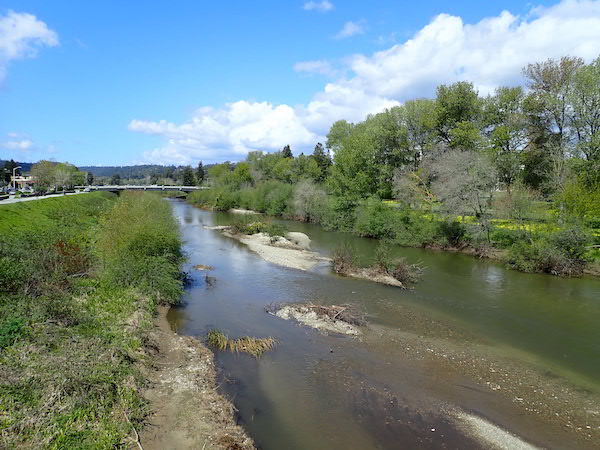Fish Report for 4-22-2019
Conserving Wetlands Makes Cents

by FISHBIO
4-22-2019
Placing a dollar value on nature is no easy task. The cultural benefits of natural ecosystems – such as their aesthetic or spiritual importance – tend to defy the label of a monetary value. However, nature also provides very real, very economically valuable natural benefits, known as ecosystem services, to human populations around the globe. These include supplying food, water, or other materials, as well as regulating services like preventing floods, purifying water, and preventing erosion. In a world where planning and management decisions are often based on the best use of limited funding, understanding the value of services that nature provides to us free of charge is an important factor to consider. For that reason, numerous studies have attempted to establish economic measures of such ecosystem services around the world. Among all the planet’s ecosystems, wetlands are understood to provide the greatest value of services to humanity. However, more than half of the world’s wetlands have been destroyed in the past 100 years. To refresh our understanding of wetland importance, a recent study drew upon past valuations and up-to-date spatial data to produce a current estimate of the economic value of global wetlands (Davidson et al. 2019). The results reveal that wetlands provide nearly half of the monetary value of the planet’s ecosystem services, amounting to tens of trillions of dollars, indicating they may be too precious to destroy.
Economists have been attempting to assign values to wetland ecosystem services for over twenty years, and it has long been understood that they are of immense economic value. As remote sensing technology continually improves, so do estimates of global wetland area (and consequently, their value). Expanding upon an estimate of global wetlands value as of 2011, this study incorporated new data on the size of coastal and inland wetlands, and integrated previously unassessed forested wetlands. Using the definitions provided by the Ramsar Convention, the researchers focused on inland, coastal, and nearshore marine wetlands, but did not consider human-created wetlands like rice paddies or reservoirs because past economic valuations have not assessed the value of these. Data on both recent total area and annual change in total area were available for unvegetated tidal flats, mangroves, seagrass beds, non-forested peatlands, and forested peatlands, which allowed the researchers to calculate the annual loss of monetary value relating to their destruction. To provide a standard value for comparisons between estimates, the team estimated values in terms of international dollars (Int$), which in this case are the amount of goods and services a U.S. dollar would buy as of 2011.
The study estimated an astounding value of wetlands totaling Int$47.4 trillion per year, which represented a whopping 45.3% of the total value of all natural biomes on the planet. This means that the tiny 3% of the planet’s surface area that wetlands represent are punching well above their weight in the ecosystem services they provide. Certain types of wetlands also provided disproportionately large values. Coastal wetlands, for example, only made up about 15% of total wetland area but were estimated to provide 43% of total wetland ecosystem service value. Inland wetlands also provided immense value, mostly as a result of their regulating services such as flow regulation, waste processing, water purification, erosion prevention, and nutrient cycling. Among those wetland types for which changes in area were assessed, a staggering loss of Int$47.8 million in ecosystem services was estimated to be occurring every year as a result of their destruction and degradation.
The authors of this publication emphasize that these dollar values are approximations, but also suggest they are likely underestimates of the true value of wetland ecosystem services. They recommend that future studies would benefit by incorporating important variables that have yet to be addressed like income, interdependencies among ecosystem services, human population size, sustainable use, fragmentation, and ecosystem scarcity. In spite of their evident value, wetlands continue to dwindle around the world. This is particularly true in California, as only about 3% of historical tidal wetland in the Sacramento-San Joaquin Delta remains today. Clearly communicating the economic importance of these ecosystems to policy-makers and stakeholders is essential for guiding the decision-making process. FISHBIO is intimately familiar with this need, as we’ve conducted studies seeking to establish the value of wetland ecosystems in the Mekong region. Wetlands foot the bill for us on numerous important services, and conserving and restoring these ecosystems will pay dividends in the face of a changing climate and growing human population.
FISHBIO is a dedicated group of research scientists, engineers, and technicians that specialize in counting, tracking, and analyzing trends in fish and wildlife populations throughout the world. An expert staff, technical capacity, and state-of-the-art equipment make FISHBIO a trailblazer in aquatic research. For more information, please visit FISHBIO.com
More Reports

4-15-2019
You might think it would be relatively straightforward to tell whether the size of an animal population is shrinking, stable,...... Read More
State of the San Lorenzo Marks 40 Years of Santa Cruz Conservation
San Lorenzo River
4-8-2019
Flowing directly through the heart of Santa Cruz, California, the San Lorenzo River serves as a vital water source for...... Read More

Website Hosting and Design provided by TECK.net